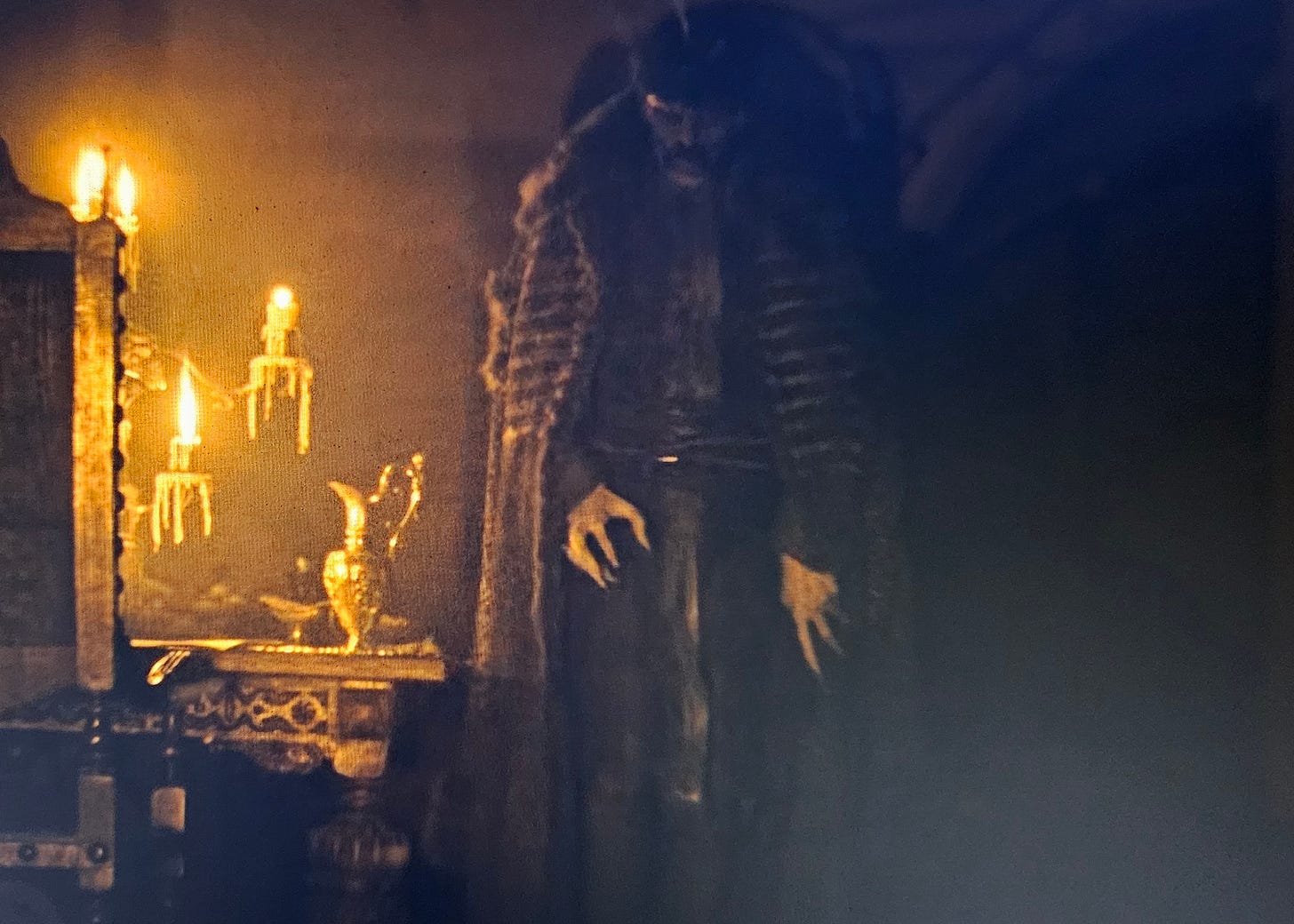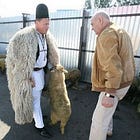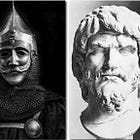The better sl00ts of our nature: in life have they damned us; in death will they redeem us
Incels REBUFFED in Robert Eggers' Nosferatu, a message film for our times!
Robert Eggers’ latest film, Nosferatu, was released on Christmas Day 2024—more than a month prior to the time of writing, so it’s not like I’m trying to ‘catch the zeigeist’ or whatever. I’m just trying something different bro: a morsel of tasteful commentary on pop culture bro. Why not after all? Geographically it’s within muh ‘wheelhouse’, and I can’t keep writing the same two articles over and over again.
The title I’ve given this piece is straight clickbait. I don’t really have much to say about the sexual polytricks (so boring) of this unpleasant but very atmospheric and involving film. What I do have to say on the topic, which will be of interest only to wimmin and homosexuals, I get out of the way early. Most of the rest consists in point-missing pedantry about Eggers’ infidelity to folklore and (pre)history and a couple of anecdotes to show you that the Romania of the Real is as accursed/enchanted a place as the Romania of the Reel. Beforehand, for those few of you still reading, here’s a little background.
A LITTLE BACKGROUND
Nosferatu is set in a Hanseatic-looking town on the German Baltic coast(?) and, of course, in Transylvania. As you know, it’s a wampyr film—the vampire is called Count Orlok, not Nosferatu and not Dracula—but the real main character is female (just like, until recently, the future was supposed to be). As you also know, Lily-Rose Depp does extremely well as Ellen.1 You will have noticed in addition that she doesn’t look at all German, but her very dark hair and eyes set her apart from everyone else and emphasise her doomed feyness.
A further thing you already know is that the plot is si
Look man I realise you’ve seen the damned thing. Indulge me. I genuinely think film reviews are more enjoyable to read après avoir visionné.
The plot is simple. If you’ve seen any of the other films based at all closely on Bram Stoker’s book there will be no surprises. Thomas Hutter, Ellen’s husband, an ambitious young striver in the high summer of German Romanticism, travels to Transylvania to close a real estate contract with the ailing scion of an ancient noble line. Lodged in the Count’s preposterously terrifying Carpathian castle, he conducts himself with comical westoid petit-bourgeois civililty until, upon realising that the uncanny claw-handed aristocrat has a fixation on his wife, his composure completely collapses.
Hutter escapes the Count’s clutches by misadventure and after a brief recovery at an Orthodox convent rushes home, intending but failing to prevent the inevitable rough wooing. The Count too travels to Germany—by sea, from landlocked Transylvania wtf—to take up his residence in the married couple’s hometown of Wisberg (fictional) and sets about destroying everything in order to get to Ellen.
Scene by scene, this Nosferatu follows pretty nearly Coppola’s silly but likeable (and maybe scarier) Dracula from 1992. I can’t say, not having seen it, whether Coppola in turn borrowed from the original 1922 version. He probably did.
This is one scene that reminds me of Coppola’s Dracula (there are many others).
In general Nosferatu is a film of the ‘show, don’t tell’ type, like all the best in Thee Fantasy genre. As this fellow points out, there’s hardly any explanation of the history or general characteristics of vampirism; the viewer is assumed to know what a vampire is. In this I see no problem. In these times, when Marvel can rely for certain on public familiarity with the ‘characters’ in its ‘IP franchise’, it would seem a bit undignified for a film maker to engage in detailed exposition of an archetype that is the stuff of so much antique European folklore. Perhaps there is some small reassurance in Eggers’ confidence that his audience still knows what a vampire is.
Eggers’ sl00ts
Eggers’ last female-centred film was The Witch (2015), in which the sl00t Thomasin, played by Hyperborean sylph Anya Taylor-Joy, is inexorably drawn to express herself as a SeXUaL BeInG. She kills her mother, provokes the death of the rest of her family and finally becomes wholly of her own volition the evil satanic bitch her mother always thought she was. Lo doth willingly or unwillingly the sl00t, in her tumescent prurience, bring about the destruction of THE PATRIARCHY—and that means, as much in the 17th century New England wilderness as everywhere else, civilisation itself. Perhaps Eggers intended The Witch as a simping feminist statement. I doubt it. Regardless, the film was, as they say, ‘catnip’ for incels: Lascivious Satanic Hoowah Destroys America!
Nosferatu’s Ellen is also temperamentally a ßl00t, early visited (as ’a child’, she says) by the thoroughly maleficent Orlok, or by his projected self, and psychosexually tormented by him even—or more to the point particularly—after her marriage. Orlok is, as he says,
ĂN ÂPPÉTÎTÉ
and he recognises the same essence in Ellen. She cherishes a forlorn hope of redemption through pure matrimonial love, yet in the end finds salvation…ONLY IN DEATH!
I guess it depends on how you read the ‘directorial voice’, but to me it’s pretty plain that Eggers treats Der Ewige ßl00t much more sympathetically in Nosferatu than he does in The Witch. Ellen, in her conscious mind sincerely in love with her would-be saviour/husband and desirous of a conventional petit-bourgeois married life, is unable to sunder her concupiscent subconscious âppétîté for Orlok.2 The only solution is surrender. But, unlike Thomasin in The Witch, by finally giving up her lifelong struggle against the inner ßl00t, Ellen—a trve tragic heroine—saves civilisation.
I don’t want to dwell any further on the message of this film. It could be, as averred here, that it’s about nothing except itself—a bit of ‘fun’. But it could be that Eggers is incalculably BASED and TRAD. Is he saying that teh Sl00ts are in life our curse and in death our salvation? Does he believe in the primacy of nature over custom, the intuitive over the rational, the aristocrat over the merchant? Is he trying to say that Romanticism was but a self-flattering cloak over Reason and that both are bourgeois vanities, pathetically inadequate in the face of the truly irrational and all too real forces present in this world? This chap seems to think so.
Hey man you’ve seen it too; you tell me.
QUIBBLES
Where Nosferatu fails worst is in the least sense that Eggers probably imagines it does. He is often praised for his commitment to mytho-historical accuracy. With this film he was only half committed. Such laxity is common in Hollywood of course; think of the dismemberment of the source material engaged in by films like Troy, Gladiator, the Lord of the Rings series or Braveheart. To this Eggers seems to pride himself on being an exception. However, I will give you here a few quibbles to be going on with. You be the judge of how much they matter.
The ruination of a Romano-Magyar aristocrat through his initiation into the Solomonari rings false. The Solomonari was a group of initiates drawn by THE DEVIL HIMSELF from the peasantry, not from members of the Transylvanian warrior class to which Orlok belongs.3 They are said to have been red-haired—another variant of the bum rap gingers always seem to get—and in some tellings even to have been Jews. Marxist anthropologists would probably say something like 'The tale of the Solomonari was a primitive folkloric myth meant to reaffirm and perpetuate feudal relations of production ,jhfytjdkuyg.jlb.ln.lhkjvm'
In addition to misunderstanding the caste-bound character of the Solomonari, Eggers hired somebody to 'reconstruct' the Dacian language. Orlok’s extraordinary accent is presumably meant to be Dacian; no Romanian or Hungarian has an accent like the Count’s. Yet there are no original texts whatsoever in Dacian, only a few words of disputed provenience and, granting that it even existed distinct from Thracian or other old Balkan languages, nobody has spoken it for nearly 2,000 years. The language they made up for Nosferatu sounds great (VERY INDO-EUROPEAN!) and adds much atmosphere, but there’s no way it can be authentic. It sounds to me like *PIE with a bit of Romanian thrown in insouciantly to cover the lacunae, but I haven’t listened closely and probably won’t bother. If you’re really into this kind of thing, you might want to look at one or both of these writings.
I suppose the idea Eggers was trying to get across with this ‘reconstructed’ Dacian is that the Count is *very old indeed*. But, if he was by birth a Dacian, he would already have been ancient in the mid-15th century (the time of the 'real' Vlad III Drăculea), and in order to have attained to such longevity he must have learned the black arts of the Solomonari long before then. If so, he can't be 'Drăculea' (ie the son of the Dragon, he being the historical Vlad II Dracul).
What I’m getting at with these ACKCHEWALLYs is that, by only half-arsedly serving mytho-historical accuracy, Eggers made Nosferatu (like most other Hollywood films) historically incoherent. I know ACKCHEWALLYs usually miss the point—see George RR Martin's self-exposingly way-off and hilarious kwibbling about Tolkien's failure to specify King Aragorn's taxation policy for Gondor and the like—but whatever I thought I’d chuck in a few to bulk this one up a bit. I guess the retort is that Nosferatu is chiefly an atmosphere piece, so who cares, and in any case accuracy is not the same as authenticity, the effect of the whole cannot be derived from the sum of its parts etc etc
I accept it all.
DULL AND UNRELATED ANECDOTES
The last thing I want to bring up here is that Romania (not just Transylvania) is in fact—and not only in fiction—a strange place. It’s possible that I am projecting my own westoid preconceptions onto the landscape; it might even be that I am subject to hallucinations. Yet I, having never before been very much receptive to the supernatural, have seen odd things all over this country. Two examples will, I think, suffice to induce in the reader first vague amusement and second an unpleasurable sensation of somnolence.
A year or so ago at dusk, while engaged, as was then my habitual wont, in a solitary two-mile winter constitutional in a forest near my former abode in Muntenia, I chanced to see…a black shape. At a safe remove I had now and again seen wild boar and deer in that forest, but what I saw on this occasion was something else.
By some means I cannot comprehend, I became conscious of this…entity when it had reached a distance of no more than 20 feet from my person—and this although its passage across the forest floor had been perfectly silent. I paused in my perambulation and looked towards it. It was approximately the size of a bear cub and exhibited a similar gait.
A veil of sorts descended of a sudden on the world; withal I was quite unstartled and unafraid. The beast turned its head slowly and looked towards me shortly in its turn. It then continued on its own peregrination. Save for its indistinctness, it evinced no stereotypical quality of the occult—no shining red eyes & c.
Still unalarmed, but sensing the prudence of turning for home without delay, I departed the forest at a quickened pace and did not look back. Thenceforth I returned only once. I did not see it a second time. I still cannot explain to myself what it was.
On another occasion, while walking on a bare ridge of the Cindrel range (a spooky region!) some years ago, I observed the imminence of a storm. Hurrying to reach a tope of tall conifers at slightly lower altitude—an error, as I now realise—I descried at a distance of some 50 feet a shepherd, garbed in clop and cojoc,4 attending his flock. He regarded me with a most sinister smile, disdained to return my rushed greeting, and showed no sign of seeking cover for himself or his charges. There was in view no mountain hovel, no covering rock and no other sheltering contrivance of man or nature.
I soon reached the tope. The tempest raged briefly—its duration can have been no more than five minutes—and when it had exhausted itself I was utterly innundated but unharmed. Throughout, from my place of refuge I could observe the shepherd’s former position; but I found to my dismay that the man and his flock had disappeared completely. Nor when I regained the ridge was there any sign, given to eye or to ear, of him or his flock.
Singular!
Such encounters make it easier at least to understand the apotropeic complexion of popular Romanian religious practice!
I believe the Solomonari really exist!
Goodbye!
The acting overall is good to excellent; weakest of the bunch is Willem Defoe, but it’s a hammy character so…
For whatever it’s worth I read somewhere that Eggers in a ‘Jungian’ but film directors are always saying shit like that to make themselves and their films seem more interesting so idk
Reader Ourokouros corrects me!
‘solomonari were originally called zgrimințeși and were more or less the local equivalent of the Odinic Grey Wanderer. They became (renamed) evil devilish lowstatusdysgenicis only in later myths, i strongly suspect due to church influence’
OK!
All the same, depicting Orlok in the garb of a 15th-18th century(?) boyar while having him speak pre-Roman ‘Dacian’ seems to me a howling anachronism. Maybe Eggers meant to imply that the language had been preserved down the ages among the Zgrimințeși-Solomonari for magical purposes.
Email me with trade enquiries!







Perhaps you will resist, but I humbly suggest that you take the time to cover more of the intricate histories of Romania, especially from this angle. What angle? That of direct story telling. Damn. You are good. Could you do some journalism, as in, chase down interesting individuals for stories? I am certain such material would find readers.
No... I didn't see it and probably won't see it. I hate watching american films set at least partially in this region because I quickly get annoyed by the incoherences.
Of course people still know what is a vampire. We're not that far removed from all those cringy vampire movies and series. Why did they always went back to high school? Nevermind.
If it's true, that the concept of the "eternal sl00t" what is being played out, then it is somewhat huge. Even a few years back any implications of this would have meant instant deplatforming. Or just as you mentioned his prior film, it was allowed as a feminist power fantasy. You go Girl!
I'm much more interested in your stories in the forest/mountains. It is a magical place isn't it. I wrote about likewise stuff previously in the Lake of Lerna substack. He does like these para stuff.
If I get synchronised with my slavic self (and why wouldn't I be) I would say that the black one was the "Chort" (or the "black one"...I know...very abstract huehuehue). If he didn't bring you with him then congrats...you're not worthy of hell (or was not worthy at that point).
I'm almost completely sure that the second one was the "Leshy" (the forest spirit). They are not malevolent, they are a force of nature so more like chaotic natural. He does have a mischievous side of him. You don't want to get on his bad side though. He liked you so all good. (he is often depicted as a shepherd tending to his flock).
Yeah I know...It was probably a wild boar or bear cub. You did good with going back the same way you came. That's the best you can do if you have no weapon with you(well...even if you do have a rifle it is the best course of action.
For the second one...people tend to underestimate the mountain people. I had a mountain guide once who was almost 90 and were going up and down quicker and steadier on the slopes than the guys in their 20s. He could have easily made it home in 5 minutes and already downed his first shot of palincă.